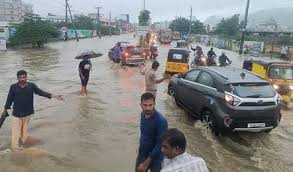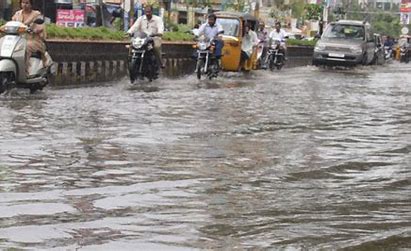
Introduction
DISASTERTelangana: Rains Hit Normal Life in Khammam, Kothagudem; Low-lying Areas Inundated 2024 DISASTER In recent days, incessant rains have wreaked havoc across Telangana, severely impacting the districts of Khammam and Kothagudem. The downpour has not only disrupted daily life but has also led to the inundation of low-lying areas, causing significant distress to the local population. This article delves into the extent of the damage, the response from authorities, and the challenges faced by the residents.
Table of Contents
The Deluge and Its Impact
DISASTER The monsoon season in Telangana often brings heavy rains, but this year has been particularly severe. Both Khammam and Kothagudem have experienced relentless rainfall, resulting in waterlogging and flooding in several areas. The downpour began earlier this week and has shown no signs of abating, with weather forecasts predicting continued heavy rainfall over the coming days.
In Khammam, many residential colonies and commercial areas have been submerged, with water levels rising to dangerous heights. The situation in Kothagudem is equally dire, with several villages cut off due to the overflowing of local rivers and streams.
Low-lying Areas: The Hardest Hit
Low-lying areas have borne the brunt of the rains, with water entering homes and shops, causing extensive damage to property and belongings. Residents in these areas are struggling to cope with the sudden influx of water, which has also led to the contamination of drinking water supplies, posing a serious health risk.
In Khammam, neighborhoods such as Prakash Nagar, Shanti Nagar, and Sarathinagar have been severely affected. The residents of these areas have had to wade through knee-deep water, and many have been forced to evacuate their homes, seeking shelter in safer locations.
Kothagudem has witnessed similar scenes of devastation. The low-lying areas around the Bhadrachalam temple town are particularly affected, with the Godavari River swelling beyond its banks. The local administration has been working tirelessly to provide relief, but the sheer scale of the inundation has made the task immensely challenging.
Infrastructure and Transportation Disrupted
DISASTER The relentless rains have also taken a toll on infrastructure and transportation. Roads in both Khammam and Kothagudem are waterlogged, making commuting a daunting task. Many roads have developed potholes and cracks, further exacerbating the situation.
Public transport has been severely disrupted, with buses and auto-rickshaws finding it difficult to navigate the flooded streets. In some areas, the water levels are so high that boats have been deployed to rescue stranded residents. The railway services have also been affected, with several trains being delayed or canceled due to water on the tracks.

Agricultural Damage
The agricultural sector in these districts has also suffered significant setbacks. Paddy fields, which were in various stages of growth, are now submerged under water. Farmers, who depend on the monsoon for a good harvest, are now facing the grim prospect of crop loss. The flooding has also damaged irrigation canals and farm infrastructure, further compounding the woes of the agricultural community.
Response from Authorities
The state government, along with local administration, has been proactive in its response to the crisis. Relief camps have been set up in various parts of Khammam and Kothagudem to provide shelter and basic necessities to the affected residents. Medical teams have been deployed to these camps to attend to health issues and prevent the outbreak of water-borne diseases.
Efforts are also underway to drain the water from inundated areas. Pumps and other equipment have been brought in, and the municipal workers are working round the clock to clear the water. Additionally, the state government has announced financial assistance for those who have lost their homes and belongings in the floods.
Challenges in Relief Operations
DISASTERDespite the best efforts of the authorities, the relief operations have encountered several challenges. The continuous rain has hampered the efforts to drain water and restore normalcy. The damaged infrastructure has made it difficult to reach some of the worst-hit areas, delaying the delivery of aid and assistance.
Moreover, the sheer number of affected people has overwhelmed the relief camps, leading to shortages of food, water, and other essential supplies. The authorities are working to address these issues, but the scale of the disaster has made it a daunting task.
Community and Volunteer Efforts
In the face of this calamity, the resilience and solidarity of the community have shone through. Local volunteers, along with various non-governmental organizations (NGOs), have stepped up to assist in the relief efforts. They have been distributing food, water, and clothing to the affected families and helping to evacuate those in immediate danger.
Social media has played a significant role in coordinating these efforts. Residents are using platforms like WhatsApp, Facebook, and Twitter to share information about areas in need, request assistance, and mobilize resources. This grassroots response has been crucial in supplementing the official relief operations and ensuring that help reaches those who need it most.
Long-term Solutions and Preventive Measures
The recurring nature of such floods in Telangana highlights the need for long-term solutions and preventive measures. Experts suggest that better urban planning and improved drainage systems are essential to mitigate the impact of heavy rains. There is also a need for regular maintenance of existing infrastructure to ensure that it can cope with extreme weather conditions.
Additionally, creating awareness among residents about the risks and encouraging them to take precautionary measures can help reduce the impact of such disasters. Community-based disaster management plans, involving local residents in planning and response activities, can also enhance the resilience of these areas to future floods.
Conclusion
The recent rains in Khammam and Kothagudem have caused widespread disruption and distress, inundating low-lying areas and affecting thousands of residents. While the response from authorities and the community has been commendable, the scale of the disaster underscores the need for long-term solutions to prevent such occurrences in the future. As the rains continue, the focus remains on providing immediate relief and support to those affected, while also planning for a more resilient future.










